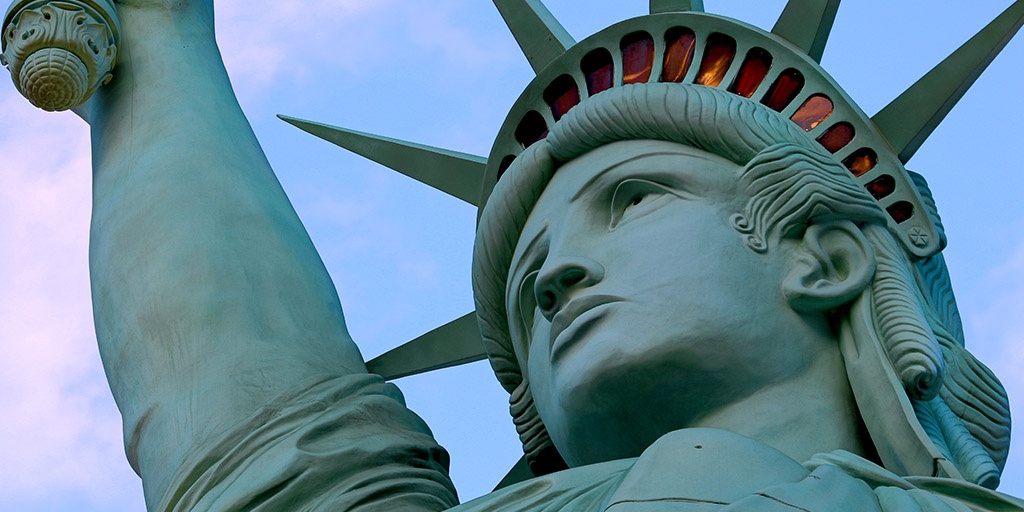Lavish buildings, technological marvels, and gorgeous art have been a hallmark of human society since modern man has been in existence. Poets and historians of the ancient world extolled the virtues of the incredible buildings they saw, but sadly, time is tough on man’s creations. Most of the marvels we’ve read about from antiquity have fallen victim over the years to fire, earthquakes, wars, or the endless erosion of wind and water. At this point, only one of the Ancient Wonders is still standing.
Here in New York City, however, we’re not about to let time and weather stop us from having the best darn structures in the whole world. That’s why today’s article is all about how NYC has resurrected every single one of the Seven Ancient Wonders of the World – and where you can find them, right here in our city.
“I am starting to love the willful ignorance of New Yorkers, the ability to look at the epic and beautiful and quickly put it into context. It's a skill that comes from the skyline; we see something that magnificent every day and somehow go on living. A backdrop like that will dominate you unless you learn to become a part of it, and that's what New Yorkers do. Become towers.” -- Rachel Syme, “ESB"
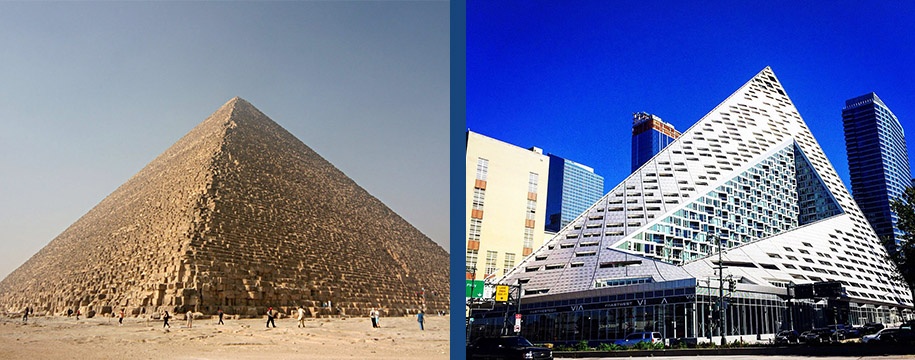 Photo Credit: 'Kheops-Pyramid' by Nina under CC BY-SA 3.0 (left) | 'VIA 57 West' by Razvan Dinu' under CC BY-SA 4.0 (right)
Photo Credit: 'Kheops-Pyramid' by Nina under CC BY-SA 3.0 (left) | 'VIA 57 West' by Razvan Dinu' under CC BY-SA 4.0 (right)
1. Great Pyramid at Giza
The Great Pyramid at Giza, located on the west bank of the Nile River north of Cairo, was built between 2700 BC and 2500 BC as a royal tomb to house the Egyptian king Khufu. It’s the largest of Egypt’s three famous pyramids and, at 460 feet tall, it was the tallest structure in the world for nearly 4,000 years. It took 23 years to build. It is the only one of the Seven Ancient Wonders still standing today.
NYC’s Great Pyramid: VIA 57 West
VIA 57 West, that fascinating pyramid structure just off the West Side Highway, is built to offer sunset views to tenants on both the west and east sides of the oddly-shaped building. Though it’s seven feet taller than the original Great Pyramid, we admit that it’s not technically a pyramid itself.
A “hyperbolic paraboloid,” with two straight sides, an intentional dip in the center, and a courtyard cutout, the sloping roof VIA 57 West goes from “the height of a handrail” all the way to “the height of a high rise,” according to the architect, Bjarke Ingels. Here in NYC we’ve just managed to take the pyramid to a new level.
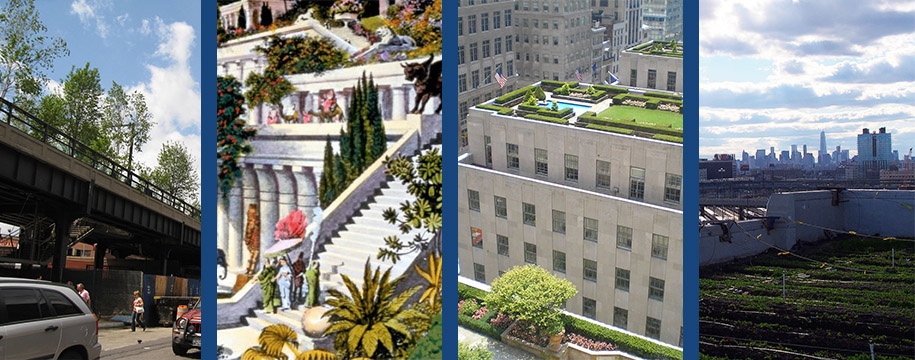 Photo Credit: 'Highline NYC' by JessyeAnne under CC BY 2.0 (far left) | 'Hanging Gardens of Babylon' (left) | 'RockCenterRooftopGardens' by David Shankbone under CC BY-SA 2.5 (right) | 'Brooklyn Grange View' by Steven Bornholtz under CC BY-SA 4.0 (far right)
Photo Credit: 'Highline NYC' by JessyeAnne under CC BY 2.0 (far left) | 'Hanging Gardens of Babylon' (left) | 'RockCenterRooftopGardens' by David Shankbone under CC BY-SA 2.5 (right) | 'Brooklyn Grange View' by Steven Bornholtz under CC BY-SA 4.0 (far right)
2. Hanging Gardens of Babylon
We’re not sure where the Hanging Gardens of Babylon were located, but we hear they were gorgeous. The lush gardens were constructed 75 feet high in the air on a series of terraces, with cascading greenery that poured over the structure like waterfalls. Filled with exotic, dazzling plants and fragrances, it would have been watered with an elaborate system of pulleys, water screws, aqueducts, and pumps.
NYC’s Hanging Gardens: Rockefeller Center Roof Gardens
The beautifully manicured Rockefeller Center Roof Gardens, closed to the public, are located 140 feet above street level on multiple buildings. The original architects wanted to connect the rooftops with soaring pedestrian bridges so it felt exactly like Babylon’s hanging gardens, but they “settled” for incredible fountains, planters, and lawns.
NYC’s Hanging Gardens II: The High Line
After a 1.45 mile freight rail was officially closed in 1980, it was reimagined as an urban oasis in 1999. The High Line park took a decade to set up, but since 2009 it’s been amazing millions of annual visitors with orchestrated microseasons that bloom and die within days of one another to create an endlessly changing natural canvas 30 feet above street level.
NYC’s Hanging Gardens III: Brooklyn Grange
The leading green roofing business in the US, Brooklyn Grange soil farm covers two buildings and grows over 50,000 lbs. of organic produce each year. Started in 2010, the rooftop farming company now also raises rooftop hens, rooftop bees, and hosts community activities. If you’re looking for more agriculture, check out forage-friendly, floating Swale, which opened in 2016.
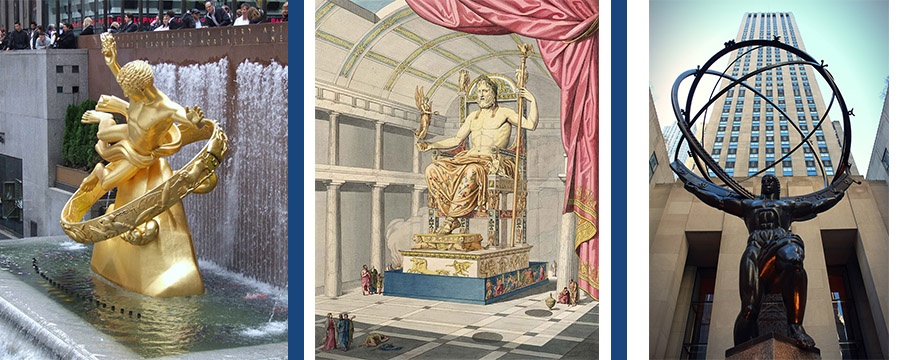 Photo Credit: 'Prometheus Statue' by Andy C under CC BY-SA 3.0 (left) | 'Jupiter Olympien' (middle) | 'Nyc Rockefeller Center NYC Atlas Monument' (right)
Photo Credit: 'Prometheus Statue' by Andy C under CC BY-SA 3.0 (left) | 'Jupiter Olympien' (middle) | 'Nyc Rockefeller Center NYC Atlas Monument' (right)
3. Statue of Zeus at Olympia
Created by Phidias, a celebrated sculptor in ancient Athens, the statue of Zeus towered 40 feet high in a temple on the site of the original Olympics. Its gold-and-ivory-covered form depicted the god bare-chested, sitting in a detailed wooden throne with arms supported by sphinxes. Built in the mid-5th century BC, it stood in the temple for more than eight centuries until it was moved and then destroyed in a fire in 462 AD.
NYC’s Zeus: Prometheus
The famous Prometheus statue at the Rockefeller Center was crafted in 1934 by sculptor Paul Manship. It’s not only the best-known sculpture at Rockefeller Center, it’s the most photographed piece of art in NYC. The 18-foot, gilded statue of fire-bringing Prometheus soars above a fountain and watches us as we perform our own Olympic feats on the skating rink each winter.
NYC’s Zeus II: Atlas
Disappointed by Prometheus’s modest height as compared to the ancient statue of Zeus? Atlas, sculpted in 1937, is the largest statue at Rockefeller Center, stretching 45 feet tall. The statue depicts Atlas, a Titan doomed to carry the earth on his straining shoulders, and it’s the collaboration between artists Lee Lawrie and Rene Paul Chambellan.
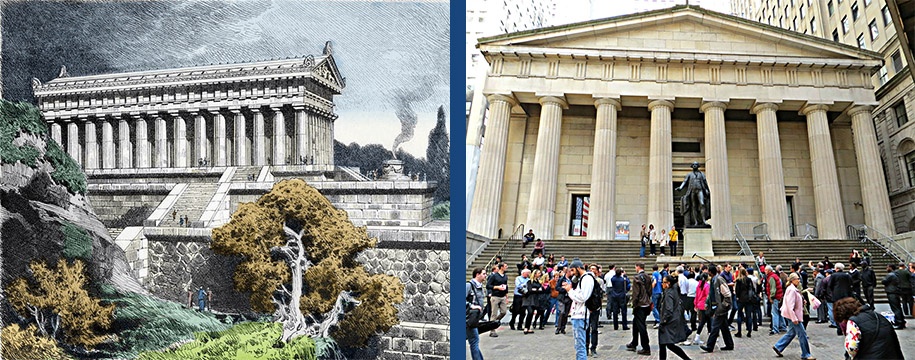 Photo Credit: 'Temple of Diana at Ephesus' (left) | 'Federal Hall National Memorial' by John Wisniewski under CC BY-ND 2.0 (right)
Photo Credit: 'Temple of Diana at Ephesus' (left) | 'Federal Hall National Memorial' by John Wisniewski under CC BY-ND 2.0 (right)
4. Temple of Artemis at Ephesus
Ephesus, a Greek port city, held a few Temples of Artemis built, destroyed, and rebuilt on the same site, but the two most impressive were built in 550 BC and 350 BC. The one from 550 BC was designed and built by an architect named Chersiphron and his son, Metagenes, and was decorated by renowned artists from all over the world. It burned to the ground July 21, 356 BC, the same day Alexander the Great was born.
The next Temple of Artemis at Ephesus, built in 350 BC, featured marble steps, a 400-foot-long terrace, 127 60-foot marble columns, and a beautiful statue of Artemis. After 6,000 years, it too was destroyed, this time by the Ostragoths, who invaded Ephesus in 262 AD.
NYC’s Temple: Federal Hall
Interestingly, Federal Hall was also built and rebuilt on the same site. Originally constructed under British rule in 1699, Federal Hall (called “City Hall”) was made of salvaged stone from the city’s destroyed north defense wall. DC was still a swamp when America declared independence, so George Washington was sworn in and worked here in New York until the Capitol Building was constructed.
Renamed and completely remodeled by 1789, the new Federal Hall was the “first building in America designed to exalt the national spirit, in what would come to be known as the Federal style” (David McCullough, historian). Federal style was based on the Founding Fathers’ personal preferences. The neoclassical architecture symbolized Athenian democracy. In 1812, Federal Hall was torn down and what we visit now was actually built as a customs house in 1842.
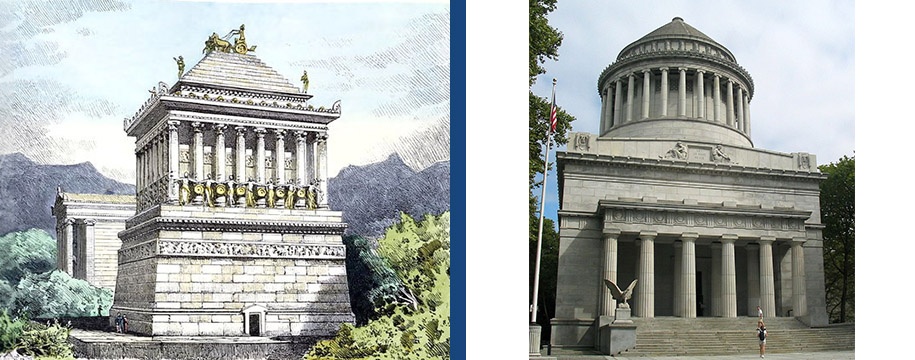 Photo Credit: 'Mausoleum at Halicarnassus' (left) | 'USA grants tomb' by Daniel Schwen under CC BY-SA 3.0 (right)
Photo Credit: 'Mausoleum at Halicarnassus' (left) | 'USA grants tomb' by Daniel Schwen under CC BY-SA 3.0 (right)
5. Mausoleum at Halicarnassus
Built as an extravagant tomb in 353 BC to house the remains of Artemisia’s husband (and brother) Mausolus, the 135-foot-high structure was made entirely of white marble and featured a complex design of three rectangular layers. The bottom layer was a 60-foot base of steps, the next layer held 36 Ionic columns and a stepped, pyramid roof, and the top layer was the tomb, decorated with a 20-foot sculpture of a four-horse chariot. It was destroyed in an earthquake in the 13th century.
NYC’s Mausoleum: Grant’s Tomb
Also a famous burial ground (who’s buried there?), Grant’s Tomb, officially named the General Grant National Memorial, houses Ulysses S. Grant and his wife Julia. Grant lived in New York and died penniless after a bad investment, so the tomb, one of the largest mausoleums in the world, was built with more than $600,000 of public donations. The 150-foot-high structure was designed by architect John Duncan with Halicarnassus in mind. Its three stages consist of a square bottom layer with thick Doric columns, a second layer with a tall circular drum supported by thin Corinthian columns, and a third layer with a stepped dome and a five-ton capstone. Though the original plan included many sculptures, those didn’t make it into the final product.
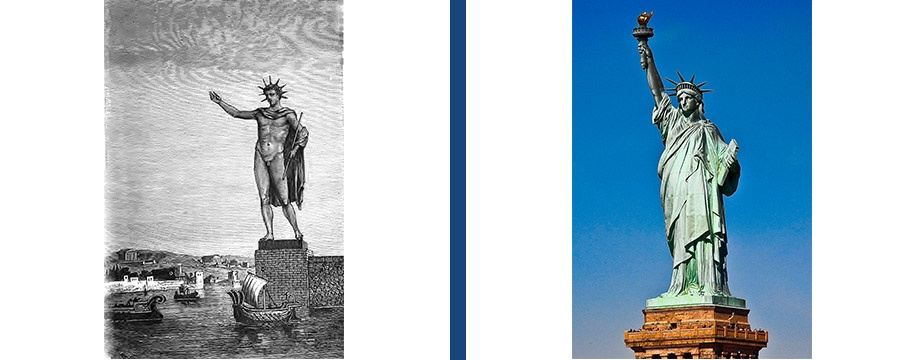 Photo Credit: 'Colosse de Rhodes' (left) | 'Statue of liberty' by Francisco Diez under CC BY 2.0 (right)
Photo Credit: 'Colosse de Rhodes' (left) | 'Statue of liberty' by Francisco Diez under CC BY 2.0 (right)
6. Colossus of Rhodes
The Colossus of Rhodes, a bronze sculpture of the sun god Helios, took 12 years for its sculptor, Chares, to build. It was finished in 280 BC. At 110 feet, it was the tallest sculpture in the ancient world, showing a naked Helios lifting a torch in one hand and holding a spear in the other. Once thought to straddle Rhodes’s harbor entrance, the statue towered over ships for 60 years until it was toppled in an earthquake.
NYC’s Colossus: The Statue of Liberty
151 feet in height, the Statue of Liberty who guards our harbor is officially named Liberty Enlightening the World. She required 200,000 pounds of 2.4mm thick copper sheeting for covering, and she was built on a flexible structure conceived by Gustave Eiffel (yup, that Eiffel), which resists cracking and moves slightly in the wind. Liberty’s design exactly matches images of Colossus from the 1880s, and Emma Lazarus’s famous poem, “The New Colossus,” was written for the Statue of Liberty and specifically references the Rhodian statue.
Incidentally, did you know that the statue was originally pitched by sculptor Frédéric Auguste Bartholdi to Egypt as a lighthouse? Did you also know that America didn’t want the statue because its pedestal was too expensive to build? The history of the Statue of Liberty is pretty awesome and deserves a read.
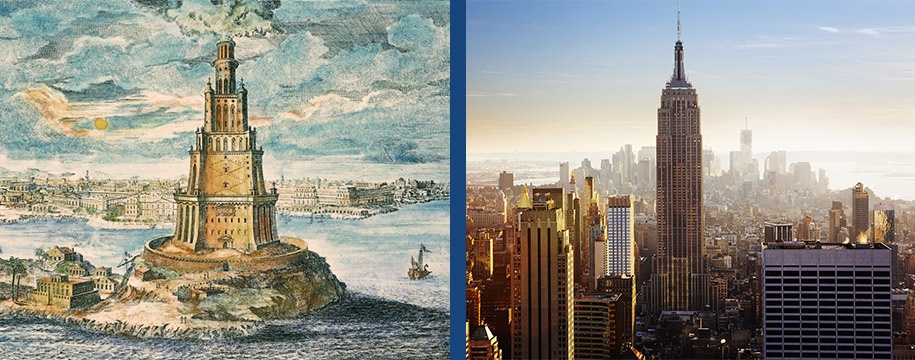 Photo Credit: 'Pharos Alexandria' (left) | 'Empire State Building' by Unsplash (right)
Photo Credit: 'Pharos Alexandria' (left) | 'Empire State Building' by Unsplash (right)
7. Lighthouse at Alexandria
Technically located on Pharos, a small island in the harbor at Alexandria (Egypt), the Lighthouse at Alexandria was designed by Greek architect Sostratos in 270 BC and was the first lighthouse ever. Rising 380 feet high to be the second-tallest structure in the world, the lighthouse was composed of three limestone tiers. The bottom tier was square and sealed with molten lead to protect from the elements, the middle was octagonal, and the top was cylindrical and crowned with a 16-foot statue, probably of Alexander the Great. Though gradually destroyed by a series of earthquakes from 956-1323 AD, the Lighthouse at Alexandria stood for more than 1600 years.
NYC’s Lighthouse: The Empire State Building
The fabulous lightshows at the Empire State Building make it a modern-day lighthouse that reaches 1,454 feet into the air (including the tip). It was the first building with 100 stories, was the tallest structure in the world from 1931–1967, and is now listed as the only American inclusion in the Seven Wonders of the Modern World. The building knows its history: a stained glass image in the Empire State Building’s lobby pays homage to its ancient predecessor, but it can’t possibly survive time as well as the lighthouse did. If the Empire State Building were to stand as long as the Lighthouse at Alexandria, it would still be around in the year 3481.
How Will You Make Your Mark?
Time may wear down buildings themselves, but the creators of the world’s most timeless structures have lived on in our imaginations for millennia. From the Egyptian king Khufu to the sculptors Phidias and Chares to the architects Chersiphron and Sostratos, we know about and revere the designers, artists, and craftsmen of the great ancient works who have made their mark on history.
See the wonder all around us in this great city. Subscribe to Insights for more fascinating reads, published regularly.


